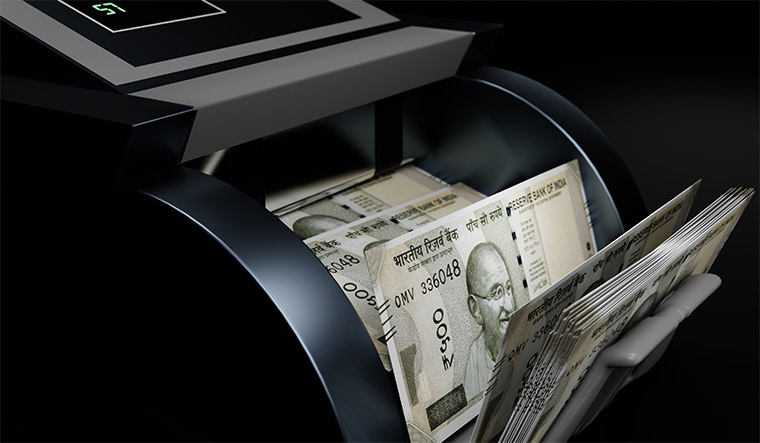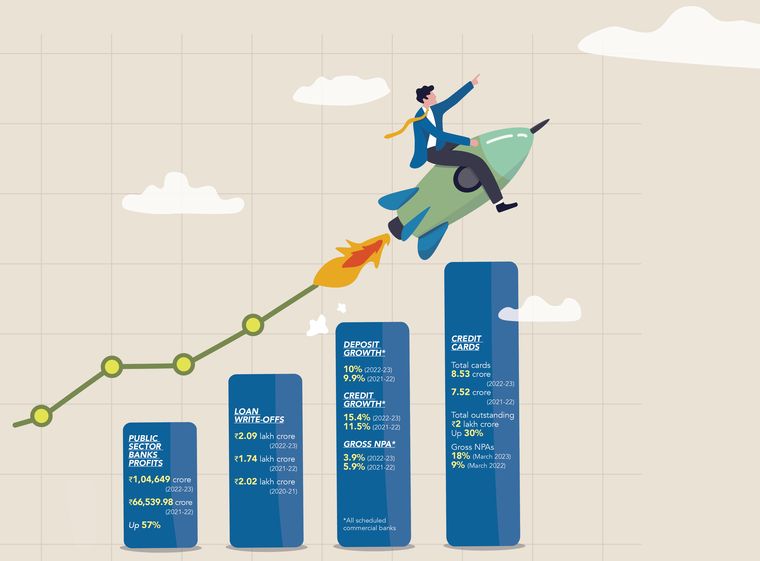The year 2018 was a particularly bad one for India’s banks―losses ballooned and bad debt was spiralling out of control. The gross non-performing assets (loans that have gone bad) of scheduled commercial banks were 11.5 per cent in March 2018, and that of state-owned lenders were 14.6 per cent, prompting the Reserve Bank to initiate strong measures to save the sector from sinking.
Five years later, however, things cannot be more different. Gross NPAs of scheduled commercial banks in March 2023 are 3.9 per cent, the lowest in a decade. The net NPAs were just 1 per cent, a level not seen since 2011. And profits are soaring. The cumulative profits of public sector banks were more than Rs1 lakh crore in 2022-23, a sharp contrast with the Rs85,000 crore net loss they reported in 2017-18.
One of the many reforms that the government initiated in the banking sector in the past few years was consolidation of public sector banks. Several small PSU lenders were merged with larger ones―Dena Bank and Vijaya Bank were merged into Bank of Baroda; Andhra Bank and Corporation Bank were merged into Union Bank of India; United Bank and Oriental Bank of Commerce were merged into Punjab National Bank; Allahabad Bank was merged into Indian Bank; and Canara Bank took over Syndicate Bank. The state-owned banks have shrunk from 27 in March 2017 to just 12 now.
“This strengthened the market position of many of these banks,” said Ajit Velonie, senior director, CRISIL Ratings. “This has also led to greater efficiency in operations and capital utilisation.”
In the latest April-June quarter, State Bank of India, the country’s biggest lender, registered a net profit jump of 178 per cent to Rs16,884 crore, from Rs6,068 crore a year ago. HDFC Bank, the largest private sector lender, reported a 30 per cent year-on-year rise in standalone net profit at Rs11,952 crore in the same period, and ICICI Bank reported a net profit of Rs9,648 crore, up 40 per cent.
Banks over the past few quarters have been boosted by a strong growth in credit, which has outrun the growth in deposits. Last financial year, for instance, scheduled commercial banks saw close to 15 per cent credit growth. A year earlier, this was just 11.5 per cent.
Notably, the credit growth this time around has largely been driven by retail customers, rather than large corporate borrowers. In fact, with companies still facing supply-related bottlenecks and concerns about a slowing economy, new investment and large capital expenditure programmes are yet to pick up. On the other hand, the housing sector is seeing a strong revival. According to data from realty consultancy Knight Frank, housing sales in the top eight cities were 1.56 lakh units in January-July 2023, the second highest in the decade in that period.
Small-ticket loans and personal loans have also seen double-digit growth, as discretionary spending increased. “Retail has been growing at a healthy pace and gaining share in the overall loan book of banks. Within this, while home loans have been growing steadily, unsecured loans have grown faster. This trend is expected to continue,” said Subha Sri Narayanan, director, CRISIL Ratings.
The ease of getting credit is one of the main reasons behind the growth of retail loans. “Digital and information-oriented lending is fuelling the growth of retail credit, especially in unsecured consumption-led products, which grew at 47 per cent between March 2021 and March 2023,” said Rajesh Kumar, MD and CEO of TransUnion CIBIL.
Even as retail credit growth is expected to remain strong this year, some experts are concerned about it, especially the growth on unsecured credit. The total number of credit cards rose from 7.52 crore in 2021-22 to 8.53 crore in 2022-23, and the total credit card outstanding rose to Rs2 lakh crore, a 30 per cent yearly increase. And the gross NPAs for credit cards have increased to 18 per cent in March 2023, from around 9 per cent a year earlier.
While the reduction in the overall NPAs has helped banks improve profits, there are concerns about the slow recovery from the bad loans. Also, a major reason behind the reduction in bank NPAs is loan write-offs. Typically, banks write off loans when chances of recovery are low, and move them from assets to losses. In 2022-23, banks wrote off around Rs2.09 lakh crore; in 2021-22, Rs1.74 lakh crore; and in 2020-21, Rs2.02 lakh crore.
To be fair, a loan write-off does not mean that a bank is giving up on it; it is technical in nature. For instance, once an account becomes an NPA, the bank has to make provisions for it, and these get augmented depending on the age of the NPA and its realisable value over time. Once the NPA has been fully provided for, banks, as a part of their balance sheet management, write off the loan. But they still have to try to recover from it as much as possible. In the past three years, though, they have recovered just about 18.6 per cent of loan write-offs―Rs1.09 lakh crore of Rs5.86 lakh crore.
The dismal recovery has not escaped the regulator’s gaze. Swaminathan Janakiraman, deputy governor of RBI, said that this issue was discussed in a recent interaction of the RBI governor and chief executives of banks. “We would like the banks to redouble their efforts and we would like to see more and more recoveries because they directly go into aiding the profit and loss of the banks and contribute to the financial well being of the banks,” he said.
Karthik Srinivasan, senior vice president at rating agency ICRA, says he will be watchful of the rising interest rates, overleveraging by the borrowers because of easy credit availability and slower wage growth in certain sectors as they can “potentially have an adverse impact on retail asset quality”.
As of now, however, the overall asset quality in the retail portfolio is stable, thanks to the higher share of home loans. Gross NPAs in the retail segment have declined to 1.4 per cent as on March 31, compared with 1.8 per cent a year earlier and 2 per cent in 2018, said CRISIL’s Narayanan.
Corporates have largely strengthened their balance sheets in the past few years and the NPAs in the corporate loan segment are expected to come down further, say analysts. Still, there are a few things to watch out for.
Veloni pointed out that volatile commodity prices had impacted profitability, especially that of micro, small and medium enterprises (MSME). Also, export-oriented sectors are facing headwinds emerging from the slowdown in their major markets. “This may not lead to any significant increase in slippages in the near term, but it is important to monitor any emerging risks,” he said.
While the consolidation phase of public sector banks seems over, it is still under way in the private sector. HDFC, the country’s largest housing finance company, merged itself to its subsidiary HDFC Bank, which will be a big boost for the country’s second largest lender on various fronts.
First, HDFC Bank is getting a large secured loan book on its balance sheet, which, in turn, will reduce the share of unsecured loans. Second, HDFC Bank can now sell all its products to the large customer base that comes with HDFC. Third, HDFC Bank was earlier only a distributor of the products of HDFC’s sister concerns. Now all these companies―HDFC Securities, HDFC Asset Management, HDB Financial, HDFC Ergo General Insurance, HDFC Life Insurance and HDFC Capital―will become subsidiaries of HDFC Bank.
“HDFC Bank with its stronger digital platforms and physical branch network will have the ability to offer the home loan customer a complete bouquet of the bank’s and subsidiaries’ products and services. Savings accounts, personal loans, insurance cover, SIPs can all be bundled along with a home loan to create a compelling value proposition to the customer, that probably does not exist in the market at the scale at which this is envisaged,” said Sashidhar Jagdishan, managing director and CEO of HDFC Bank.
Infrastructure financing company IDFC Ltd has also initiated a merger with IDFC First Bank, which would simplify the corporate structure of IDFC Ltd, IDFC Financial Holding Company and IDFC First Bank into a single entity. The lender also aims to grow its balance sheet by 25 per cent a year in the near-to-medium term after the merger.
These mergers come at a time when analysts expect retail credit growth to remain strong and corporate credit growth has seen a pickup, especially for working capital. With the RBI expected to keep its benchmark repo rate on hold for some time, interest rates might have peaked and that could bode well for borrowers as EMIs will remain steady.



